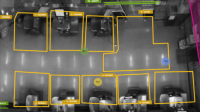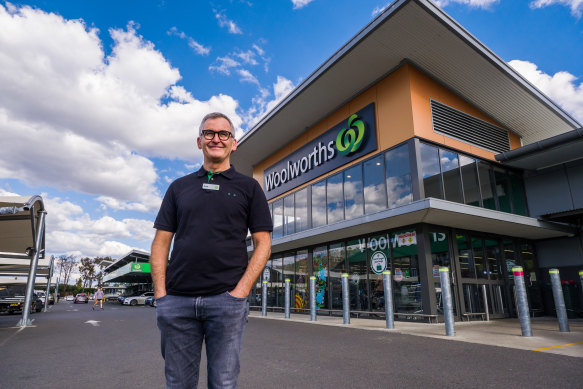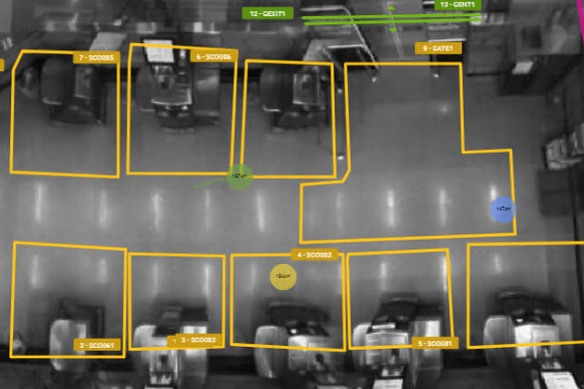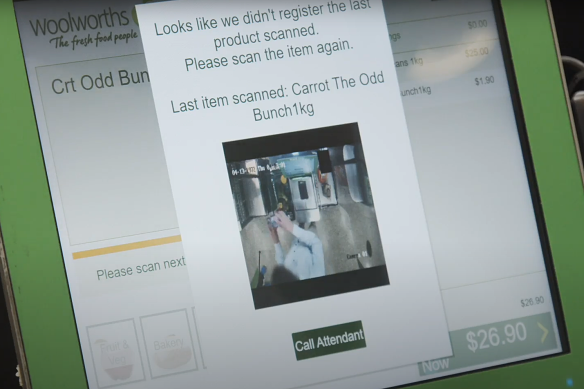Up to 70 cameras watch you buy groceries. What happens to that footage?
Save articles for later
Add articles to your saved list and come back to them any time.
Supermarkets have announced major investments into surveillance following a surge in shoplifting, but privacy advocates are concerned about what is being done to protect large amounts of biometric data from being collected.
In annual results published last week, Coles reported that total stock loss, which includes stolen goods and waste, had climbed 20 per cent, and management confirmed it would invest in a variety of measures such as smart gates to limit theft.
Woolworths similarly announced it would be investing $40 million on CCTV upgrades, body-worn cameras and wearable duress devices to address theft and aggression toward staff, with CEO Brad Banducci confirming stock lost costs between $22 million to $25 million per week.
Woolworths Group CEO Brad Banducci stressed most customers did the right thing when shopping.
Chair of the Australian Privacy Foundation David Vaile said the increasing usage of CCTV was a major concern.
“Once you start using CCTV or any sort of imaging, they’ve got the raw data from which various biometric mechanisms might be applied,” he said.
“It’s not just facial recognition or iris recognition, it could be gait recognition or voice, depending on what the sensor is picking up.”
Vaile stressed it was unlikely that supermarket employees would be accessing or analysing this data, but external service providers were capable of doing so.
“There’s the lack of reciprocity when you have technology like this. You don’t get to know what a company is doing, so you can’t even decide if you don’t want to be paranoid,” he said.
“I think there’s a good reason to be very suspicious.”
Last year it was revealed Kmart and Bunnings were using facial recognition technology in stores, which is under an ongoing formal investigation by the Office of the Australian Information Commissioner (OAIC).
The average Woolworths has 62 CCTV cameras throughout the store, while each self-checkout desk has between six and eight cameras, along with an overhead camera, with AI determining whether the correct products are being scanned.
Some stores are also trialling activity-tracking sensors to detect when a shopper has paid to open an exit gate, while 500 stock-monitoring cameras have been mounted to the underside of shelves.
Sensors in Woolworths track activity, communicating with the self-checkout and smart gates about when a customer had paid and is approaching the exit.
A spokesperson for Woolworths confirmed the stock monitoring cameras silhouette out customers or staff, while the self-serve checkout cameras blurred faces, blacked out PIN pads and were not viewed live.
The spokesperson said the sensors and stock monitoring cameras were of “a number of initiatives, both covert and overt, to minimise instances of retail crime” across Woolworths Group stores, and customer feedback would be considered before they were expanded.
The spokesperson also confirmed that all CCTV footage was stored locally and only accessed by store team leaders and the investigation teams, along with police if necessary, while self-scan checkout footage was stored in Australia.
“We have robust privacy policies and procedures as well as operational measures in place to ensure ongoing monitoring and oversight of the technologies we trial or implement,” the spokesperson said, adding Woolworths was compliant with privacy laws.
A spokesperson for Coles declined to say where its CCTV footage was stored or who it could be accessed by.
“Like most businesses and public spaces, we use surveillance technologies in accordance with stringent privacy laws, and we have strict protocols in place around access to the footage,” the spokesperson said.
Cameras at Woolworth checkouts use AI to check items are scanned correctly.
The OAIC Australian Community Attitudes to Privacy Survey, released earlier this month, found 62 per cent of Australians see the protection of their personal information as a major concern in their life, while over a quarter identified surveillance by Australian entities as one of the biggest privacy risks faced today.
In her Privacy Awareness Week opening address in May, OIAC and Privacy Commissioner Angelene Falk warned that automated facial recognition tools could covertly collect large amounts of biometric data, without customers being aware it was happening.
“This limits the effectiveness of traditional privacy self-management mechanisms such as notice and consent to provide individuals with control over their personal information,” she said.
A spokesperson for Attorney-General Mark Dreyfus said the government was committed to protecting Australians’ personal information, including their biometric information such as facial images.
“The Attorney-General’s Department has recently completed a comprehensive review of the Privacy Act which has looked at the use of emerging technologies such as facial recognition technology,” the spokesperson said.
“The government is now consulting widely as we consider how best to respond to these new challenges and ensure we can properly protect privacy in the digital age.”
The Morning Edition newsletter is our guide to the day’s most important and interesting stories, analysis and insights. Sign up here.
Most Viewed in National
From our partners
Source: Read Full Article






